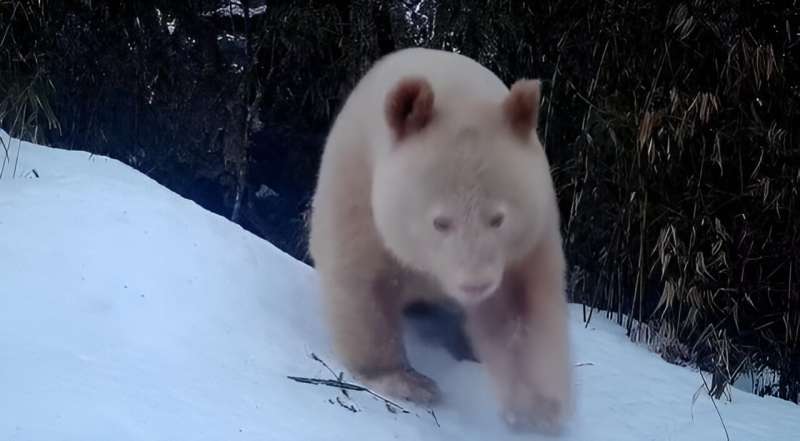Credit: Peking University
Four years ago, in a twist of fate, an all-white "bear-like" creature spotted in a nature reserve in China's Sichuan Province was identified by zoologists as the world's only albino giant panda. (The giant panda is classified as a species of bear.)
Since then, scientists, including researchers from PKU's School of Life Sciences, have closely monitored the habits and characteristics of the animal, which recently brought about a series of new findings—including the panda's gender.
Timeline:
- In April 2019, the distinctive creature burst into sight after infrared cameras captured it about 2,000 meters above sea level in the Wolong National Nature Reserve.
- In February 2023, Infrared cameras captured footage of the all-white panda approaching a mother panda and her cub in the Wolong National Nature Reserve.
- In September 2023, through a DNA test, researchers identified the albino panda as male, and footage from infrared cameras showed that it has been growing healthily and communicating and interacting normally with other wild pandas in the nature reserve.
The research team collected nearly 1,000 monitoring data points over four years, documenting the interactions between the white panda and various wild pandas, including behaviors such as feeding, marking territory, and potential mating and fighting.
Credit: Peking University
It took researchers more than 10 hours to climb to the panda's habitat at 2,000–3,200 meters above sea level and collect fresh stool samples.
The activity range of the albino panda is over 5 square kilometers and its dependence on bamboo is no different from other pandas.
"The white panda has built positive relationships with other individuals in the area. This remarkable adaptation illustrates the high-quality habitat, adequate food resources, and effective conservation measures provided by the reserve," said Li Sheng, a researcher at Peking University's School of Life Sciences.
"The frequency of its appearance is highest during the spring, which coincides with the mating season for giant pandas. Researchers are collecting feces and hair samples for DNA analysis, in hopes of gaining insight into its biology," said Tan Yingchun, a senior engineer at the Wolong National Nature Reserve, "The goal is to find out if there are other giant pandas keeping company with the white one in the area."
Provided by Peking University
























